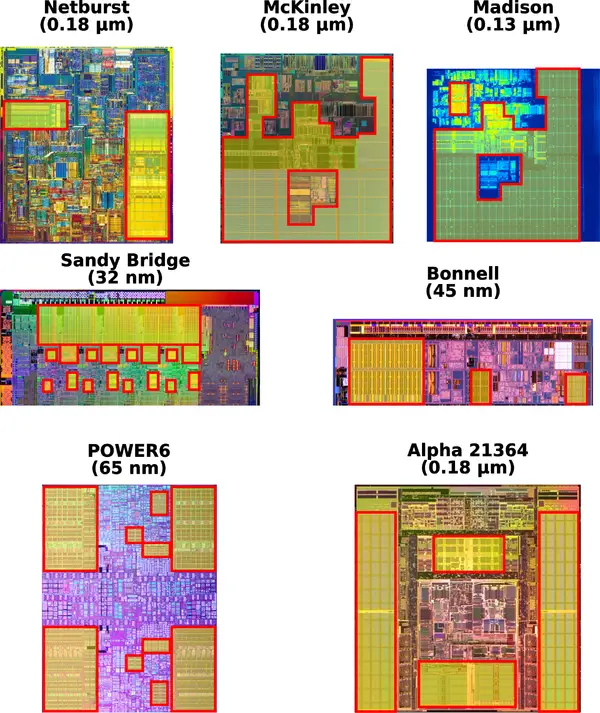(→Overview) |
(→Applications) |
||
| Line 9: | Line 9: | ||
=== Applications === | === Applications === | ||
Due to its relative simplicity, SRAM is the most common memory cell found in modern [[microprocessors]]. It is used for various large buffers and caches. Current SoCs allocate a large portion of the die to SRAM. For example, in Intel's first-generation {{intel|Atom}} processors, codename {{intel|Bonnel|l=arch}}, 30,644,682 out of the 47,212,207 transistors (65%) were dedicated to the [[level 2 cache]]. In Intel's Itanium 2, codename {{intel|Montecito|l=arch}}, 90% of the 1.72-billion transistors were occupied by SRAM. | Due to its relative simplicity, SRAM is the most common memory cell found in modern [[microprocessors]]. It is used for various large buffers and caches. Current SoCs allocate a large portion of the die to SRAM. For example, in Intel's first-generation {{intel|Atom}} processors, codename {{intel|Bonnel|l=arch}}, 30,644,682 out of the 47,212,207 transistors (65%) were dedicated to the [[level 2 cache]]. In Intel's Itanium 2, codename {{intel|Montecito|l=arch}}, 90% of the 1.72-billion transistors were occupied by SRAM. | ||
| + | |||
| + | Below are large SRAM blocks highlighted on real-world high-performance microprocessors, showing how much [[silicon]] area, SRAM typically occupies. | ||
| + | |||
| + | |||
| + | :[[File:large sram blocks highlighted.png|600px]] | ||
=== Operation === | === Operation === | ||
Revision as of 19:24, 31 January 2019
Static random-access memory (Static RAM or SRAM) is a simple semiconductor memory device that implements a random-access memory-based storage that holds data in a static form. That is, static RAM retains its data for as long as the memory device has power. SRAM is the most common type of memory cell found in most VLSI designs.
Contents
Overview
Static Random Access Memory (SRAM) is a type of semiconductor memory. It is static and volatile, implying data retention persists for as long as the device is powered without any form of a refresh, however, once the power is cut, data will be lost. It is random access, meaning the next memory location that can be read or written to does not depend on the last access location.
Large blocks of SRAM memory comprise of arrays of individual SRAM blocks called cells. An SRAM cell is capable of storing a single bit of data for as long as there is power. Likewise, an array of eight SRAM cells can store 1 byte of data. Arrays of SRAM form the foundation for every
Applications
Due to its relative simplicity, SRAM is the most common memory cell found in modern microprocessors. It is used for various large buffers and caches. Current SoCs allocate a large portion of the die to SRAM. For example, in Intel's first-generation Atom processors, codename Bonnel, 30,644,682 out of the 47,212,207 transistors (65%) were dedicated to the level 2 cache. In Intel's Itanium 2, codename Montecito, 90% of the 1.72-billion transistors were occupied by SRAM.
Below are large SRAM blocks highlighted on real-world high-performance microprocessors, showing how much silicon area, SRAM typically occupies.
Operation
| This section is empty; you can help add the missing info by editing this page. |
Cells
| This section is empty; you can help add the missing info by editing this page. |
4T Cell
| This section is empty; you can help add the missing info by editing this page. |
6T Cell
| This section is empty; you can help add the missing info by editing this page. |
8T Cell
| This section is empty; you can help add the missing info by editing this page. |
Leading-edge SRAM
| This section is empty; you can help add the missing info by editing this page. |
